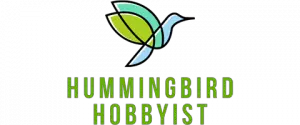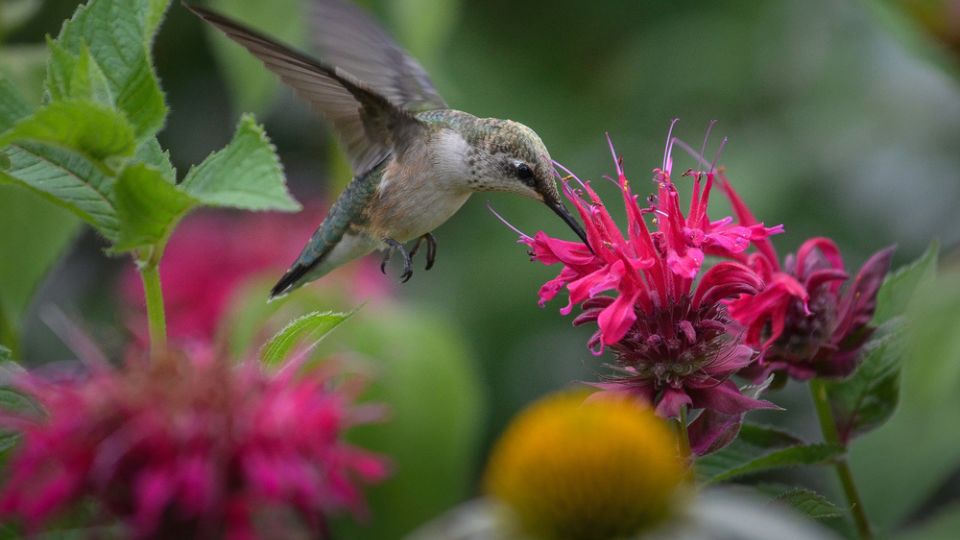Bee Balm will attract hummingbirds to visit your garden. This plant will also attract several other birds in late summer. Honeysuckle, penstemon, and salvia are also good choices to attract hummingbirds.
Plus, it’s easy to manage, so you’ll have an excellent hummingbird flower in no time. Besides bee balm, you can get many other plants to attract hummingbirds in your backyard. Keep reading to see what these plants need.
Table of Contents
How to Attract Hummingbirds to Your Garden?
There are several ways to upgrade your garden, so it attracts more hummingbirds. For example, you can use hummingbird feeders with sugar water, birdbaths, and hummingbird flowers to attract more visitors. Many of these flowers are very low-maintenance and drought-tolerant, so you don’t have to worry about garden maintenance.
If you decide to go with attractive plants, plant the flowers in early spring. Some may require partial shade and more air circulation, so keep that in mind when selecting the right kind for your yard. You might also have to ensure there’s draining soil for some plants.
However, you’ll want to pay attention to the climate. Some of these plants require specific weather conditions. To check which flowering plants you can put in your garden, consult the USDA website for your zone.
What Is a Hummingbird’s Favorite Flower?
Hummingbirds love red, yellow, orange, and purple flowers, as well as tubular flowers. Those are flowers that can produce a lot of nectar.
These include perennials, biennials, and many annual plants, such as cleomes, impatiens, or petunias. The hummingbird flowers, including Bee Balm, are:
- Cardinal flowers
- Penstemon
- Columbine
- Honeysuckle, etc
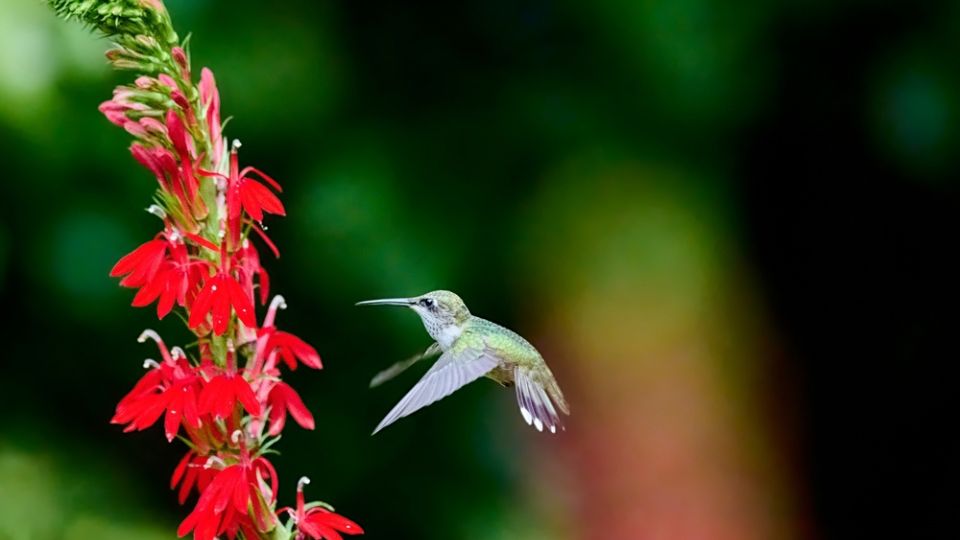
Cardinal Flower (Lobelia Cardinalis)
These flowers are named after the red robes worn by Roman Catholic cardinals. Cardinal flowers need some mulch to retain moisture during summertime.
Mulch will also protect the rooting system during cold winters. This flower is also one of the top hummingbird flowers to grow in your garden.
This plant is also deer-resistant. It belongs to the perennial kinds and loves partial shades or full sun areas. It will grow well in constantly moist soil.
Penstemon
These are North American native plants and come in many forms. Ideally, you should select the one that fits your area.
Penstemon flowers are easy to grow and low-maintenance. Just place them in the full sun area with good drainage, and they’ll also thrive during winter. Plant them in the spring—they’ll get a foothold before the cold months arrive.
These flowers also come in many colors you can choose from so you’ll find the one you’ll love. Their stems are also strong, but you might need plant support depending on the garden type.
Eastern Red Columbine
If you’re looking to add some red flowers to your garden, check out Eastern Red Columbine. Plus, this native columbine offers crimson and yellow if you need other colors. Ensure it’s planted in partial or full shade.
It loves dry or moist soil and has a high drought tolerance. It also handles heat and cold. Still, plant it in well-drained soil. It will remain evergreen unless the temperature changes. In such cases, it will stay dormant until conditions improve.
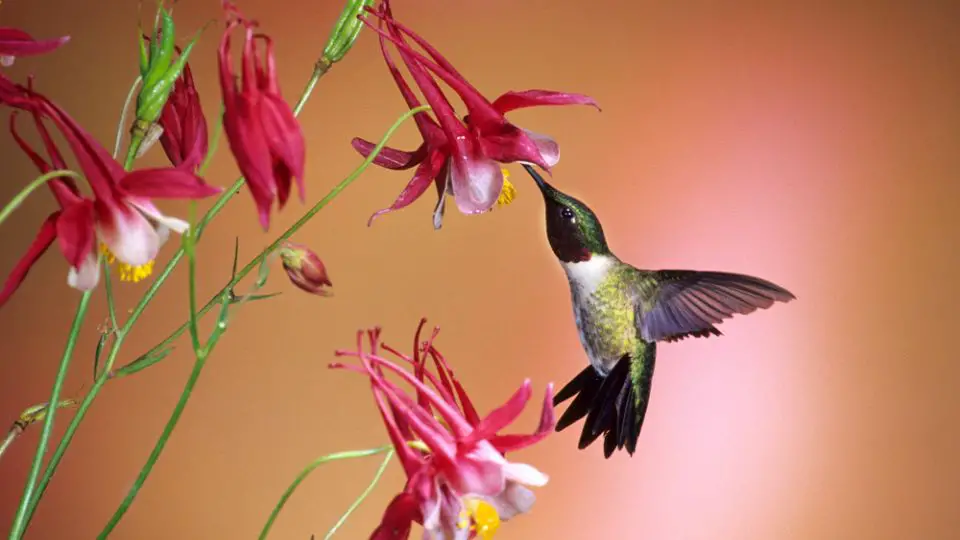
Trumpet Honeysuckle
A colorful trumpet honeysuckle vine will do wonders in full sun or part shade. Hummingbirds adore this plant and will visit it all summer long. Still, many honeysuckle plants are invasive, so plan their place accordingly.
The vine will grow up to 12 feet tall, so make sure to plant it along the fence or provide proper support. It will reach the peak of blooms in late spring, but you might notice occasional flowers until fall. You can prune it or leave it be.
Salvia
Hummingbirds also love any type of salvia plant. Its species include annual, biennial, or perennial herbaceous plants, along with woody subshrubs.
These will grow best in full sun and partial shade. Annual salvia is one of the best choices for hummingbirds. Its blooms can reach 1 to 5 feet in height.
Dominant colors are purple and indigo, but you’ll also find maroon and red variants. You’ll also notice this plant is a favorite among butterflies.
Bee Balm (known as Wild Bergamot, Monarda spp, Monarda didyma, Jacob Cline)
Bee balm plant, which also comes with several different names, is loved for its brilliant red blooms on tall, sturdy stems. Monarda belongs to the mint family, so you can also use it for tea making.
Plant this wildflower in your garden if you want a surefire way to attract hummingbirds. Bee balm grows up to 4 feet and thrives in full sun. You’ll start noticing flowers in midsummer.
There are native and cultivated varieties to choose from and both will attract hummingbirds equally. However, be careful and protect the plant from powdery mildew.
What Does Bee Balm Attract?
Bee balm attracts many hummingbirds (especially Ruby-throated hummingbirds), bees, butterflies, moths, and other natural pollinators. It’s bumblebees’ favorite.
Many claim bee balm is so effective in attracting hummingbirds that they don’t need to refill the hummingbird feeders anymore. Additionally, some birds will visit bee balm in the fall.
These birds will look for nutlets:
- Finches
- Sparrows
- Juncos
- Redpolls
Does Bee Balm Attract Hummingbirds?
Hummingbirds will love seeing scarlet bee balm in your garden. Moreover, it will spread out a beautiful minty aroma around your backyard.
It blooms in late summer, so you’ll have something to look forward to even if other flowering plants are done for the year. If you want second flowering, stimulate it with a dead heading.
Second blooms will give you more flowers, and hummingbirds will have something to munch on before migration. If you find bee balm is too invasive, divide the plant in spring and fall.
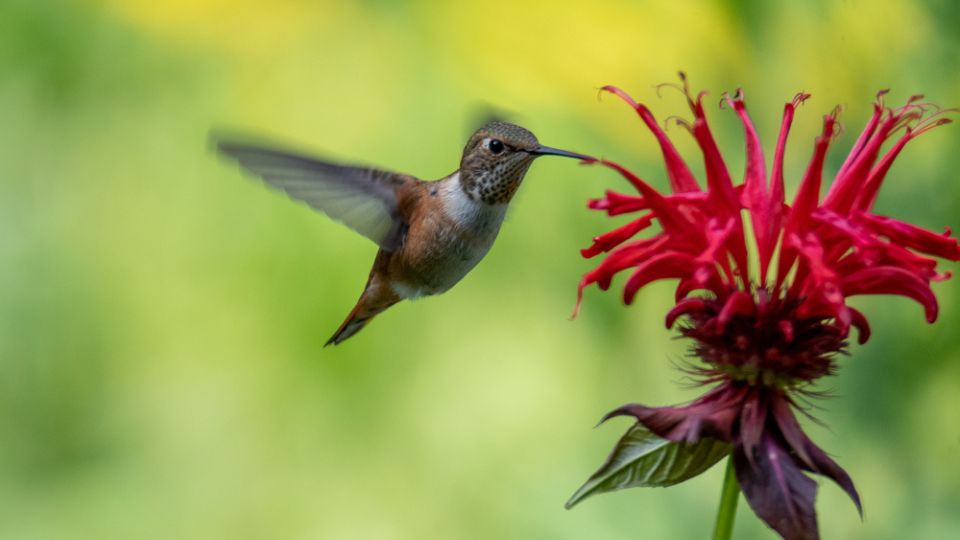
Powdery Mildew is a Problem
Even though many hummingbird flowers are mildew resistant, bee balm requires good air circulation since it’s prone to powdery mildew. It’s a fungal disease seen as light gray or whitish powder on the leaf surface.
Luckily, it’s not as dangerous as it is unsightly. This fungus will also sometimes kill your plants. You can try getting rid of it by cutting off infected leaves.
If you’re looking for natural fungicides, try neem—it’s known for its pesticide and insecticidal properties. Avoid using artificial pesticides on hummingbird plants, as those are toxic.
Bee Balm Hummingbirds Overview
Bee balm is one of the very best flowers you can plant in your garden if you want more hummingbirds. Bee balm also belongs to the mint family, so you can use it to make tea. Plus, it will spread its refreshing scent all around the garden.
However, this plant can be quite invasive. If you notice it started to spread, you can divide it into the spring and fall. Also, beware of powdery mildew, as bee balm can easily get sick from it.
